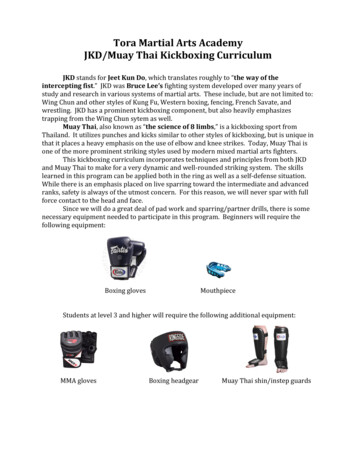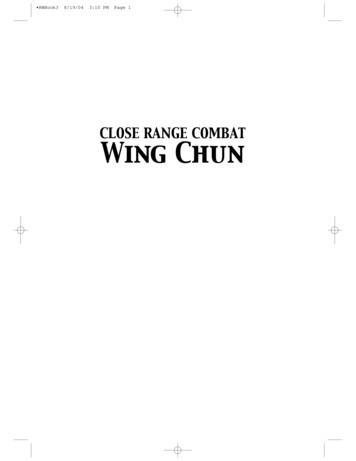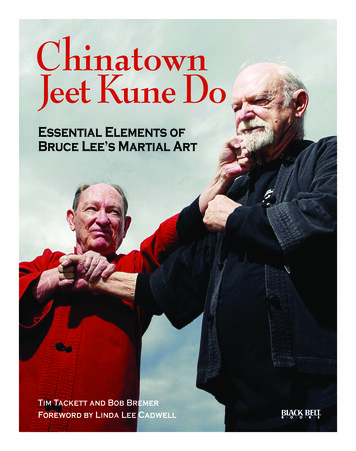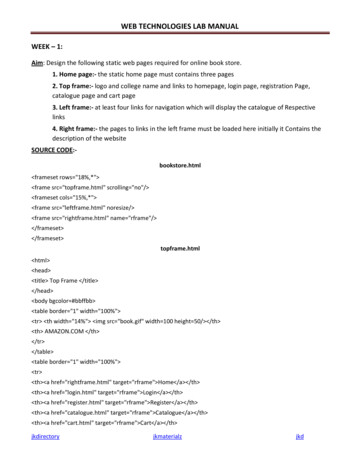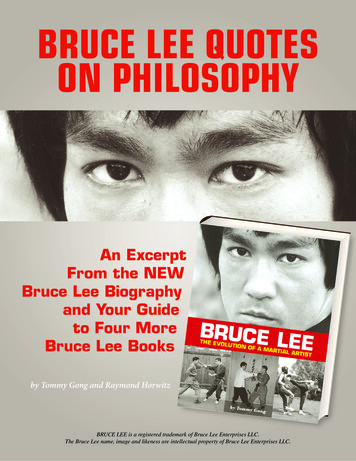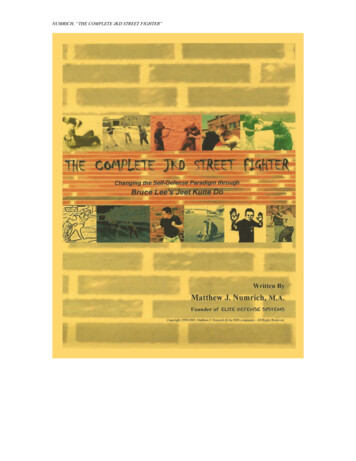
Transcription
NUMRICH, “THE COMPLETE JKD STREET FIGHTER”
NUMRICH, “THE COMPLETE JKD STREET FIGHTER”Table of ContentsPROLOGUE. 1THE AUTHOR’S . 2JKD LINEAGE . 2BRUCE LEE: . 3The Legacy of an Understatement . 3DAN INOSANTO: . 7JKD – And Then Some. 7PAUL VUNAK: . 10Creating the Cutting Edge . 10I - THE FIRST STEP . 14II - THE NEW SELF-DEFENSE PARADIGM: A STREET FIGHT . 17What is a Street Fight?. 17Changing the Paradigm of Self-Defense . 17Today’s Incorrect Packaging of Self-Defense . 19The Seven Categories . 21Traditional Martial Arts . 21Meditation Martial Arts . 21Exercise Martial Arts . 21Competition (Point) Martial Arts. 22Competition (“No Rules / NHB”) Martial Arts . 22True Self-Defense Martial Arts . 23Self-Defense . 24Lessons To . 24Five Masters and Five Mistakes . 26Learning Not to Make the Same Mistake . 29The Most Important Paradigm Shift: Areas of Combat . 30A Strong Argument for Close Quarters Range. 33How Does Tournament Competition Compare to a Street Fight?. 36Bad News for Hybrid Arts . 44III - JEET KUNE DO's ROLE IN STREET FIGHTING . 46Why Use a Street Fighting Philosophy for Self-Defense? . 46Using Jeet Kune Do as a Prism . 47
NUMRICH, “THE COMPLETE JKD STREET FIGHTER”The Hierarchy of Jeet Kune Do Concepts . 48Stages of a Fight . 53The Importance of a Game Plan . 55Law Abiding Universal Concepts. 59Levels of Response . 61Bruce with a Gun? . 64IV - JKD APPLICATIONS. 66Plan to Simplify Reality . 66Plan A vs. Plan B . 67Plan of Attack . 68Plan C?. 72JKD Illustrations . 73PART ONE ILLUSTRATIONS . 74PART TWO ILLUSTRATIONS. 78V - LEARN FIRST. 88Path of Learning . 88Knowledge . 89Gaining Knowledge . 90True Self-Knowledge: Body Types . 93VI - TRAIN IT ALL INCLUDING EMOTIONS . 96"Knowing is Not Enough" . 96The Training Continuum . 97Problem Solving With the Training Continuum. 100Using the Training Continuum for Improvement . 102Foundation of Training: The Physical Triad . 103The Three Pieces to the Complete Puzzle . 108The Invisible Piece . 110The Emotions of Each Area of Combat. 113Emotional Intensity – The 90/10 Rule. 114Training the Emotions of a Street Fight . 117Empowering Emotions . 120Emotional Transformation. 122The Emotional Paradox . 124Path of Defeating . 126The Effects of Physical Stress on All Areas . 127VII - FORGOTTEN TOOLS OF TRAINING . 133
NUMRICH, “THE COMPLETE JKD STREET FIGHTER”Assessment: Everyone's Need . 133The Importance of Goals . 134Power of Teaching . 136VIII - THE INTANGIBLE NEEDS . 138Fighting Hard or Fighting Smart . 138Quality vs. Quantity: The Importance of Heart . 140Ethics in Street Fighting . 141Three Reasons Why People Lose Fights . 143The Third Reason: More Bad News for Hybrids . 144Train How You Fight . 147The Six Common Pitfalls of Martial Artists. 149IX - JKD’s ART OF WAR: HISTORY TODAY . 152X - THE COMPLETE JKD STREET FIGHTER: TEN KEYS . 164EPILOGUE: CONCLUSION? . 167ABOUT THE AUTHOR . 169BIBLIOGRAPHY . 171Copyright 1999-2003. Matthew J. Numrich & the EDS companies. All Rights Reserved.
NUMRICH, “THE COMPLETE JKD STREET FIGHTER”DEDICATIONI would like to dedicate this work to my Lord and Savior who has given me thechance for Greatness, my grandfather John W. Platt who showed me Greatness, andmy wife Stephanie who helps me create Greatness every day in every way.ACKNOWLEDGEMENTSI would like to thank my instructors for their wisdom, my students for theirquestions, and my friends for their time. This project would not be possible withoutany of those stated above.
NUMRICH, “THE COMPLETE JKD STREET FIGHTER”DISCLAIMERPlease note that the author and/or publisher of thisinstructional book is not responsible in any manner whatsoeverfor any injury which may occur by reading and/or following theinstructions herein.It is essential that before following any ofthe activities, physical or otherwise, herein described, the readeror readers should first consult his or her physician whether thereader(s) should embark on the information described in thefollowing pages.
NUMRICH, “THE COMPLETE JKD STREET FIGHTER”PROLOGUEWhen students enter into my classes and seminars, they are ecstatic to learn the"Art of Jeet Kune Do", or "Bruce Lee's Art". Some want to "learn how to fight likeBruce", and others want to learn similar techniques, as he performed. All of them, in oneway or another, want to know the "secrets" of JKD. They want to learn the mysticalknowledge that has surrounded this art.For those who are in search for any of the above, I tell them, "Well, I have somegood news, and I have some bad news." The good news is that I do teach "Jeet KuneDo", the bad is that there is no "art" of Jeet Kune Do. After looking puzzled for a fewseconds, curiosity once again shows on their face.You may be having the sameexperience The information I instruct and have given in this book is taken from the Jeet KuneDo philosophy. There is no "Art of JKD", however there is a set of simple rules, asBruce said, "We must absorb what is useful, reject what is useless, and add what isspecifically our own." The practical and fundamental knowledge in this book is myexperiences of Jeet Kune Do. It is a mixture of what I've been instructed on, seen, heard,read, synthesized, and what I teach. Therefore, it is only my interpretation. I must saythat this book is full of information. Combining both the solid principals that JKD isbuilt upon in addition to my own extensive findings, I can say with confidence that thereis no other book which comes close to the completeness of this written work you hold inyour hands, outside of Bruce Lee’s original works.Therefore take in the information – research it, criticize it, and train with it. In theimmortal words of Bruce Lee, "my JKD is not your JKD, and your JKD is not my JKD".Therefore, take the knowledge, concepts, and philosophy in this book, and find your owntruth, your own JKD.1
NUMRICH, “THE COMPLETE JKD STREET FIGHTER”THE AUTHOR’SJKD LINEAGEBefore I get started with the information in this book, let me walk you through myJKD lineage. I am one of those unique JKD Instructors, which started in JKD, not inanother art. Therefore sources of my information are easy to find. The following threeshort biographies give a quick overview of tracking my JKD knowledge back to thesource. Meaning the high quality information and instruction I give simply come fromvery high quality practitioners: Bruce Lee, Dan Inosanto, and Paul Vunak. These areonly brief summaries of three great men, however they will give you some backgroundon their histories, experiences, and huge contributions to the martial art’s world. Over90% of the information in this book comes from these three men.In the pages following these short biographies, I have taken their findings, andattempted to make them even easier to understand. Even if I do not meet this goal, atleast you the reader have another perspective on this beautiful philosophy. In addition topresenting the JKD ideology in a different way, years of teaching and instruction in otherarts has now given me my own discoveries, which I will also illustrate in the followingchapters, and have worked into my interpretation of JKD. But as I said before, most ofthis information is from the following men. Much of this JKD information I gainedthrough readings, some from seminars, and a lot through personal instruction. As a resultI have tried to pour out as much information as possible. Although I partly dedicated thisbook to my Sifu, Paul Vunak, I owe just as much to Guru Dan Inosanto and Si BruceLee. A million thank yous would not come close to showing my feelings of gratitude.2
NUMRICH, “THE COMPLETE JKD STREET FIGHTER”BRUCE LEE:The Legacy of an UnderstatementWhen one talks about martial art legends, there may not be any dispute when itcomes to the individual called Bruce Lee. Decades ago he was a film star for the babyboomer generation, while still today he graces the t-shirts worn by third graders. Hismystical life was cut short in 1973, while his philosophy called Jeet Kune Do (JKD) stillmystifies practitioners in search of his combat secrets. Although JKD was held to closeddoor sessions for many years, Bruce’s magic still lives on through his fans across theglobe. How can one man, with such a short life, still impact so many people today – bothinside and outside the martial arts world? First, let us take a look at the three decades helived, what he changed, and what role he still plays today in martial arts.ECLECTIC FOUNDATIONBruce Lee was born in San Francisco in 1940 – ironically the year of the Dragon.His father was a star of the Chinese Opera, which probably impacted his early film spotsin overseas film hits as The Orphan and Chinese Blackboard Jungle. Highly dedicated towhatever he put his mind to, Bruce found a mentor in a teacher named Yip Man, whoopened the doors to the world of martial arts. Bruce combined the philosophies of boththe Eastern and Western world, which showed through in his combative training. Forexample, he trained both in the traditional art of Wing Chun, while also competing inschool boxing tournaments. Bruce topped off his physical activity by also becoming adance champion, which only further developed his world-renowned coordination,balance, and speed.There was no definite point when Lee created his “art” JKD, but it is obvious thathis eclectic experiences, (at the time) the country’s rebel tendencies, and the overlystructured martial arts world, all added fuel to the fire. This fire continued to spreadthrough his acting career as he starred as the side kick “Kato” in the Green Hornet. Lateron, he would continue to star in other films as the Big Boss and Enter the Dragon. Bothof these movies played a huge part in catapulting Lee into the stratosphere of Asian andAmerican popularity. However, there was still an aspect of Lee’s life that pushed him totest not only his limits, but martial arts practitioners all over the world.3
NUMRICH, “THE COMPLETE JKD STREET FIGHTER”Bruce’s busy lifestyle did not take away from his training as he continued toexperiment and discover new truths in martial arts. He was dedicated in finding the oneart that was the “truth”, as he called it. The ironic fact is that his frustration in findingthis one art, set the foundation of Jeet Kune Do. After experimenting with dozens upondozens of arts, and realizing that each had their own set of limitations, Lee made adiscovery. The answer to his quest for the “truth” came not in one art, but a philosophyof freedom. Lee realized that one art may be the solution for one moment in combat, butuseless in another. Therefore, he started to use techniques and training methods fromdifferent styles all in the same sparring session. Decades later this line of thought wouldbecome a necessity in tournaments like the Ultimate Fighting Championships (UFCs), aseven the tournament’s owner has stated, “It all started with Bruce Lee”.Soon, Bruce and his protégé Dan Inosanto were using Praying Mantis onemoment, then switching to a Savate kick, then to Western Boxing, and ending up with achoke on the ground, all in one sparring session! Every movement was dictated by whatwas needed by the moment. The Jeet Kune Do “structure less structure” was able toaccount for many ranges including kicking, boxing, trapping (close quarters), andgrappling. Inosanto expanded Lee’s knowledge on weapons, by introducing the FilipinoArts. Lee even used these arts in the movie, Game of Death – where Inosanto made acameo. Lee’s formula became a battle cry in training, as most JKD practitionerscommitted the phrases “Absorb what is useful and reject what was useless ” and “Noway as way ” to memory.MISSION: TRAPPING RANGEOne of Lee’s most interesting discoveries, that is not widely known, is the aspectof “Trapping range”. Although Bruce was known to be able to adapt from range torange, he found that there was a particular range extremely effective for combat.Trapping range, as he called it, is simply close quarters. It is the range between grapplingand boxing. Lee found that in this range size, weight, height, and even skill did not holdas much water. For instance, in trapping range one could use more effective tools aselbows, knees, and head butts. Even a smaller person can use these tools to easily take alarger opponent out of commission. Bruce knew this personally; he was only 5’5”, 125pounds. Trapping range was also easy to learn. Compare teaching the mechanics of ahead butt, to the extensive mechanics of a spinning roundhouse kick or trianglesubmission hold. These trapping range tools were also more efficient. Clock how long ittakes to throw a knee, compared to putting someone into a “heel hook” submission!This Trapping range discovery was an ignorant subject to most of the martial artsworld. This range was not used by a whole lot of martial artists at the time, besides acouple arts only scratching the surface of its effectiveness. Because of the lack ofcertified instruction in America of JKD today, trapping range is still not widely known –therefore those who know it have a huge advantage. Surprisingly enough, today’s favorof the month “Reality Combat Programs” are now adopting this close range as a greatrange to train and defend themselves in. However, if it is that effective, why did Lee not4
NUMRICH, “THE COMPLETE JKD STREET FIGHTER”show this range off in his movies? It all came down to what looks good for the screen.Bruce adapted to everything, including the movie set. Although Lee, and later on his sonBrandon, both used Trapping range in their fight choreography, its quick “non-flashy”applications didn’t demand attention on screen. This is true even today, especiallycompared to multiple unrealistic kicks Van Damme popularized in the 90’s, and themovie the Matrix showed off some years later.YESTERDAY’S IDEAS – TODAY’S IMPACT OF JKDTo this day there is no other street fighting art as complete as Bruce Lee’s JKD.That last sentence may be the most controversial statement so far, however, there is aperfect modern day example to support Bruce’s ideas showing up today. How manyopponents in the early UFC’s lost because they were limited in their ground fightingknowledge? Then, up until the last few years it was thought that ground fighting artswere the answer – as many of these schools popped up all over the US. After several ofthe first “no rules” tournaments, “ground only” opponents started to lose, because groundfighting is not the only answer. Now it is assumed that “no rules” fighters know thestand-up and ground game those who don’t, learn painfully. As a result, much of themartial arts world now believes that “Hybrid Arts” (a system which combines two ormore arts) is the answer to combat. Bruce’s findings still hold true “Just mixing” artsstill have its limitations. There is no freedom by just mixing. JKD is a process not aproduct.Today’s competitions prove Lee’s point once again but will people ever see thedifference? Only if the UFC’s bring weapons into the ring or allow mass attacks, will theHybrid practitioners realize that self-defense is not found in one, two, or even five arts. Itis found in that “structure less structure” – not the ring. Yes, Hybrid arts are effective inthe ring, but they are still limited in the street. Therefore, Lee’s JKD stays where it wasmeant to be, the street. Elite agencies are are now starting to adopt JKD. For instance,the Navy SEALs contracted out JKD Instructor Sifu Paul Vunak (student under GuruDan Inosanto) to teach them the realistic self-defense system. Currently, JKD is poppingup in the DEA’s and major police curriculums, as well. They simply realize that anyaltercation with a bad guy will have no referee – and really “No Rules”. Therefore,Bruce still continues to impact new students even though he has been gone for over 25years.5
NUMRICH, “THE COMPLETE JKD STREET FIGHTER”FUTURE PROGRESSIt seemed that Bruce Lee did it all. He made movies that captivated audiences,trained and taught with such varied talent as Chuck Norris to Kareem Abdul-Jabbar,while turning the martial arts world upside down. His JKD continues to evolve, as it wasonce stated in a popular magazine that JKD is definitely “known for its streeteffectiveness”. Besides his martial arts’ contributions, Lee was also a philosopher. Thereare many books which were released that solely focus on his intriguing thoughts aboutlife, love, family, and self-improvement. Currently, many people have many differentviews on JKD; what arts are included presently, or the exact definition of JKD. Onething that is true, is that Bruce is not dead, because the changes he started still live on.They live on through his family, friends, and practitioners all over the world. Bruce wasa product of a process. He accomplished in only one third of his life, what should havetaken three lifetimes to accomplish.Bruce Lee a legend quite possibly the biggest understatement every made.6
NUMRICH, “THE COMPLETE JKD STREET FIGHTER”DAN INOSANTO:JKD – And Then SomeIf Mr. Webster did his job correctly, one could look under “Complete MartialArtist” in the dictionary and see a picture of Guru Dan Inosanto. His picture would alsobe illustrated beside the words “Incredible Teacher”, “True Athlete”, and “Humble Man”.Guru Inosanto was the man behind the scenes of Jeet Kune Do. If Bruce Lee was theflower of JKD, then Mr. Inosanto was the soil which helped it to continue to grow. Fewknow about his life, and impact on the martial arts. The following pages do not do justiceto his life experiences, contributions to the arts, and evolution of JKD. They do,however, give a quick glimpse of truly a great man.STUDENT FROM THE STARTIf there was ever a perfect example of a person with an eclectic background, onewould have to use Dan Inosanto for their perfect example. Dan’s father came from thePhilippines, and met his mother, a half Filipina – half American woman, who was veryintelligent. Together they had Dan in 1936, which of course set off a chain of futuremartial art events that would change self-defense, as we know it. From early in his life,Dan became a vacuum for knowledge. Growing up in Stockton, California, Dan wasintroduced to such arts as boxing, jujitsu, and kali. Although he was interested in these,he found passion in sports like football and track. Showing himself as an above averageathlete, Dan developed many attributes that would help in later in his martial art’s career.Dan was later blessed by being put in an incredible learning environment - calledthe military. Dan enlisted, and got to exchange information with the other men in theservice. It was a great learning experience because everybody was learning off ofeveryone. Some days they would box, some days they would wrestle, and other daysthey would share karate based moves. At the time, Dan took up Judo instruction, whilealso studying Kung-Fu. One day he saw a practitioner of Kenpo and knew that he wouldtake that as soon as he got out of the service.Sure enough, Dan left the service and ran into his next key learning experience.One of Dan’s first huge role models in the martial arts was Ed Parker. Dan earned ablack belt under Parker and taught many classes for him. Dan’s knowledge for themartial arts grew even more by teaching, and constantly learning off of others. As amatter of fact, one of Dan’s early students was none other than Sifu Larry Hartsell. Dancontinued to compete in inter-school tournaments, which was another great learningexperience, and broadened his knowledge base.BRUCE WHO?7
NUMRICH, “THE COMPLETE JKD STREET FIGHTER”Up until now, one may be asking, where is Bruce in this story? This is becauseDan, early on, might have gained the majority of his popularity and name for trainingwith Bruce Lee. Dan actually met Bruce at Ed Parker’s first Karate Tournament in 1964.He soon became his student, and began a long and rigorous training schedule with Bruce.Through this, Dan was opened back up to the “non-critical” environment he experiencedthrough the military. Bruce soon showed an eclectic, but very scientific martial artsblend to Dan. In return, Dan continued to blend Bruce’s philosophy with his experiences.The label Bruce gave to his philosophy was obviously “Jeet Kune Do” or JKD.He conducted many demonstrations, where Dan was used as his assistant. Bruce at thetime taught three “arts” including Jun Fan gung-fu, Tao of Chinese Gung-Fu, and JKD.Inosanto earned certificates in all three, as his learning curve shot up to the sky. Bruceonly certified three people as instructors: James Lee, Taky Kimura, and Dan. Soon, Danwas doing the vast majority of teaching at Bruce’s school. Inosanto conducted classdifferently from other martial art’s schools at that time. The “research grounds” attractedmany well-known names including Joe Lewis and Chuck Norris. Through these greatteaching experiences, Dan increased his knowledge of JKD, by sparing with Bruce duringhundreds of hours of private training.Unfortunately, Bruce passed in 1973, and Inosanto truly realized that Bruce wasnot only his instructor but also friend. Dan fell into a deep bout of depression, and couldnot find the energy to teach. Upon receiving supportive letters from fellow students,friends, and instructors, Dan started teaching again. He opened the Filipino KaliAcademy where many different classes were taught, including closed-door sessions ofJun Fan Jeet Kune Do. It has been written in many sources that Bruce left Dan thereasonability of promoting and teaching the JKD philosophy. Dan since has filled theduties with style, while continuing the “JKD evolution”.After closing the Filipino Kali Academy, Dan moved, and opened the InosantoAcademy of Martial Arts, located in Los Angeles. Once again, the curriculum was thebest example of variety, including dozens of arts, styles, and cultures. Dan still uses itnot only as a school, but his personal gym as he still continues to be a student! Forexample, he strapped on his white belt in Brazilian Jiu Jitsu at age 55! His workoutscontain up to five one to two hour private session in the popular ground fighting art.When he isn’t a student, he takes the role of an instructor at the school, teaching aplethora of classes.STILL GOING Many years later, Dan still plays the double role, of both instructor and student.He is still on the seminar circuit and as travels up to half the year conducting seminarsworldwide. He teaches on a number of topics, and incorporates a number of arts in mostof his seminars. On the current state of JKD, Guru Inosanto sees it in a constant state ofgrowth and change. Indirectly, Dan has assumed the leader role of the “JKD Concepts”or “Functional JKD” family. He has been the only instructor off of Sigung Lee, which8
NUMRICH, “THE COMPLETE JKD STREET FIGHTER”has certified students in JKD. Among his instructors are the likes of Rick Tucci, RichardBustillo, Paul Vunak, Richard Burton, and his daughter Diana
The Jeet Kune Do “structure lessstructure” was able to account for many ranges including kicking, boxing, trapping (close quarters), and . NUMRICH, “THE COMPLET

